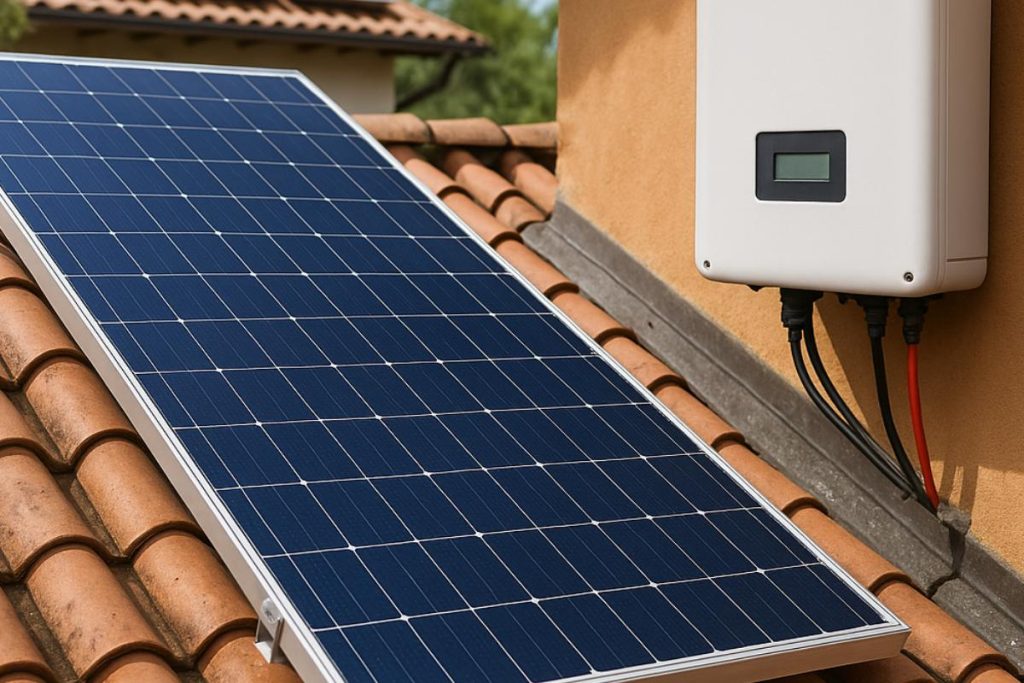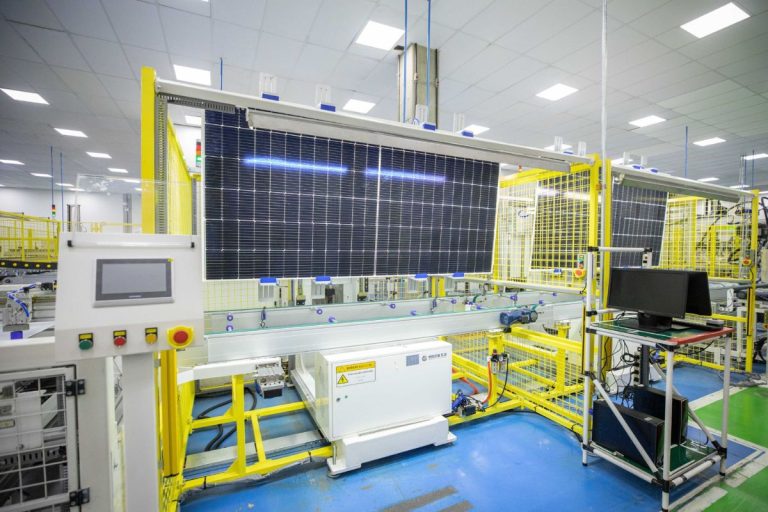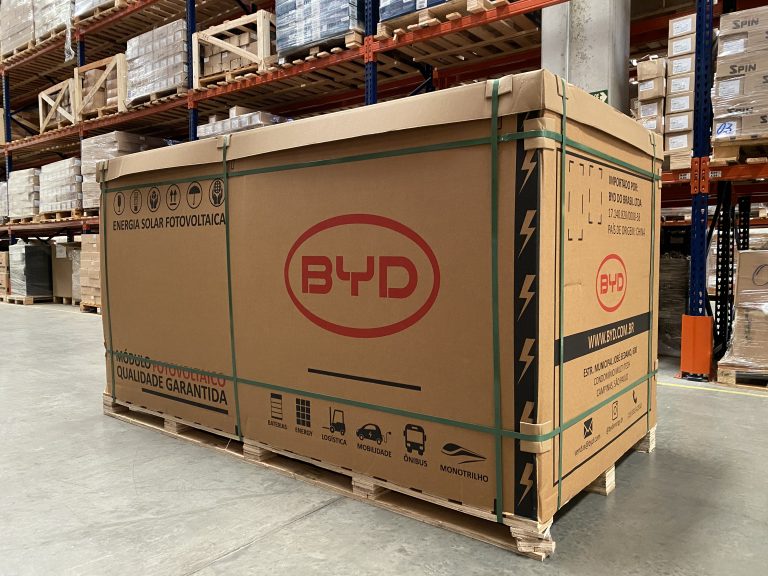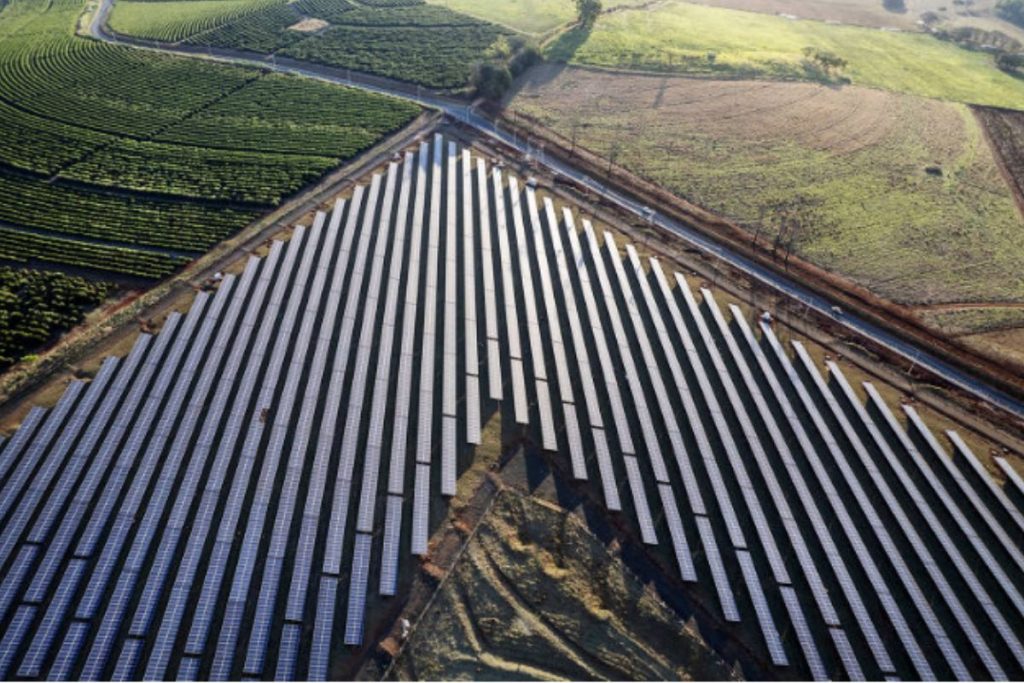O solar inverter is often called heart of the photovoltaic solar energy system, because without it the electricity generated by the panels could not be used in our household appliances. In other words, it is the equipment responsible for converting solar energy captured in a form that can be used in the common electricity grid. In addition to this conversion, the inverter ensures safety and optimizes system performance, monitoring production and preventing problems.
In this complete article, you will understand what is a solar inverter, how it workswhat are the main types of inverters available (on-grid, off-grid, hybrid, microinverter, etc.) and receive valuable tips from how to choose the best inverter for your needs.
By the end of this reading, you will be prepared to identify the ideal model, guaranteeing maximum efficiency and reliability in your solar energy project.
What is a solar inverter and what is it used for?
O solar inverter (or photovoltaic inverter) is an electronic device that is indispensable in any photovoltaic solar energy system. Its main function is to convert to direct current (DC) produced by the modules or solar panels in alternating current (AC)which is the type of energy used by most electrical equipment and the conventional power grid. In simple terms, the photovoltaic panels generate DC electricity from sunlight (photovoltaic effect), and the inverter "translates" this energy into the AC format compatible with our home or business.
In addition to making energy usable, the solar inverter also plays other key rolesIt monitors the system's performance, ensuring that the panels are operating at their maximum power; it protects against surges and automatically disconnects in the event of a fault or lack of power from the grid (in grid-connected models) to ensure safety (anti-islanding function). In summary, the solar inverter serves to convert and manage the energy from the photovoltaic system, allowing savings on electricity bills and a stable supply of electricity both in residential systems and installations commercial or industrial.
How does a solar inverter work?
The operation of a solar inverter can be explained in stages. First, the solar panels (or photovoltaic modules) capture sunlight and generate direct current (DC) electricity. This current then reaches the inverter, which uses power electronics to converting direct current into alternating current (AC) with the same characteristics as mains power (generally 127V or 220V, 60 Hz in the Brazilian standard). In this way, the solar energy becomes compatible with the appliances and can be consumed locally or injected into the public grid, depending on the type of system.
During this process, the inverter uses technologies such as MPPT (Maximum Power Point Tracking)or maximum power point tracking. This function optimizes the extraction of energy from the panels by constantly adjusting the input voltage and current to obtain the maximum possible power in various conditions (such as variation in irradiance or temperature). Thanks to MPPT, the inverter maximizes efficiency of the photovoltaic system throughout the day, even if there is partial shade or differences in orientation between groups of modules.
Another important feature is that grid-connected solar inverters monitor the utility's signal to synchronize the frequency and waveform of the output. They also have integrated protectionIt automatically switches off in the event of overload, overheating or if there is a blackout in the electricity grid (in the case of on-grid inverters). This last protection, called anti-islandingThis ensures the safety of technicians who may be repairing the electricity grid, preventing the photovoltaic system from continuing to supply the grid during maintenance.
So the solar inverter works receiving direct current from the panels, optimizing this generation and converting to alternating current quality, safe and in sync with the network (where applicable). All of this takes place automatically and silently inside the equipment, which is usually installed near the switchboard or panels, in a ventilated area sheltered from direct sunlight.
What are the types of solar inverter?
There are several types of solar inverters on the market, each suited to certain applications and needs. The main categories are differentiated by the type of system in which they are used (grid-connected or not), the presence of storage and the power configuration.
Here are the main types of solar inverter and their characteristics:
On-Grid Solar Inverter (Grid-Tie)
O on-grid inverter is the most common and widely used model in systems connected to the public power grid. This inverter, also called grid-tie or interactive inverter, is designed to operate in parallel with the electricity grid. Its main function is to inject into the network all the converted solar energy that is not being consumed on site, allowing the use of energy credits (in the distributed generation compensation system).
An important feature of the on-grid inverter is that it does not operate in isolationgrid-tie inverter: if there is a power failure (blackout), it switches off automatically for safety reasons. In other words, the grid-tie inverter depends on the presence of the network to work and no provides power in the event of a blackout (unless there is a backup system with batteries, which would already be a case of a hybrid inverter, discussed below).
This type of inverter is ideal for homes and businesses connected to the distributor, making it possible to drastically reduce electricity bills by using solar energy instantly and sending the surplus to the grid. Modern on-grid inverters have a high efficiency (usually above 97%) and include various protections. They are offered in single-phase or three-phase versionsThe range of power outputs varies from around 1 kW (for small residential systems) to hundreds of kW (for commercial systems and solar power plants).
Summary: the on-grid inverter connects the photovoltaic system to the electricity gridIt synchronizes the energy generated with that of the utility company and switches off in the event of a power failure. It is the choice for those who want to distributed generation and you don't need autonomy during blackouts.
Off-Grid Solar Inverter
As the name suggests, the off-grid inverter is used in isolated solar systemsThese systems are disconnected from the public electricity grid. In these systems, all the energy consumed must come from local solar generation and storage battery banks, as there is no grid support. The off-grid inverter is designed to operate autonomouslyIn other words, it takes the DC energy from the panels and/or batteries and converts it into AC to directly power the loads (electrical appliances in the room).
This type of inverter usually also incorporates a battery charger or works in conjunction with a charge controller, as it needs to manage the flow of energy to keep the batteries properly charged. A quality off-grid inverter ensures that, even without any connection to the external grid, the home or facility has reliable power, as long as the system is well dimensioned in panels and battery capacity. For remote locations or specific applications (such as motorhomes, boats, remote rural properties), off-grid inverters come in a variety of powers and voltages, usually standardized at 127V or 220V AC at the output, and operating with 12V, 24V, 48V DC battery banks (or more, in larger systems).
One difference between an off-grid inverter and an on-grid inverter is that it needs to provide a pure and stable sine waveform even without grid reference. It acts as the main source of AC, often synchronizing with auxiliary generators if there are any. Today, with the popularization of storage solutions, off-grid inverters have become more efficient and intelligent, allowing for remote monitoring and protection configurations similar to on-grid ones.
Typical application: The off-grid solar inverter is indispensable for those looking for grid independenceWhether you're in an area without utility service or want a stand-alone 100% system. Together with a robust battery bank, it guarantees electricity even at night or on rainy days. With battery costs falling in recent years, off-grid systems are becoming increasingly viable and attractive for certain uses (a Brazilian Photovoltaic Solar Energy Association (ABSOLAR) points out that lithium battery prices have already fallen by around 90% in the last 15 years, making storage much more affordable).
Hybrid Solar Inverter
O hybrid inverter is a kind of "two in one", combining the characteristics of on-grid and off-grid inverters. It can operate connected to the grid electricity and, at the same time, manage a battery system for energy storage. Under normal conditions, a hybrid inverter works like an on-grid - supplying the loads, injecting surplus into the grid and consuming from the grid if necessary. However, in the event of a grid failure, it acts as an off-grid inverter, supplying energy from batteries instantly, similar to a UPS. This guarantees backup during blackoutsincreasing the user's energy security.
In hybrid systems, it is common to configure which loads (circuits) will be kept running in backup mode, in order to prioritize essential equipment. For example, during a blackout, the hybrid inverter can power a fridge, basic lighting, security systems and the internet, using the stored energy. When the grid returns, the inverter synchronizes again and eventually recharges the batteries for the next eventuality. All this happens automatically.
Hybrid inverters have become popular because they offer versatilityThe benefits of distributed generation: they allow users to enjoy the benefits of distributed generation (reduction of electricity bills via credits) and still have energy autonomy in the event of a power outage. They also allow for advanced strategies, such as programming the storage to use battery power at peak tariff times, or sell energy at times of higher value and recharge at times of lower value, maximizing savings (in places with differentiated tariffs or free energy markets).
From a technical point of view, a hybrid inverter has a more complex topology, with additional components for managing battery charging and fast switching circuits. When choosing one of these, it's important to look at compatibility with the type of battery (lead-acid, lithium, etc.), output power in isolated mode and switching speed. The best models achieve a virtually instantaneous transfer (just a few milliseconds), so that the devices don't even notice the power failure.
The hybrid inverter brings the best of both worldsThe main features of this type of system are: high-efficiency operation in parallel with the grid and battery backup for autonomy. This type is suitable for those who want to protect themselves from blackouts or who want a high level of independence without giving up their connection to the grid. It is worth remembering that, because they include a storage function, hybrid inverters are more expensive than conventional on-grid inverters, but the investment can pay for itself in terms of the security and peace of mind they offer (avoiding losses due to power interruptions, for example).
Solar Microinverter
O microinverter is a special type of small power solar inverter designed to operate directly on a single solar panel or on a small array of panels. Unlike traditional string inverters (which connect dozens of modules in series), microinverters are generally installed next to each panel (or 1 microinverter for every 2 or 4 panels, depending on the model). Each microinverter converts that module's energy into AC independently.
The great advantage of this configuration is that each panel works in isolation: problems or shading in one panel do not affect the performance of the others. In systems with microinverters, there is no single central source of failure; if one microinverter malfunctions, the rest of the system continues to operate normally. This brings greater reliability and modularity. In addition, microinverters often optimize production in situations where panels are arranged in different orientations or are partially shaded at different times - a scenario in which conventional string inverters would incur significant losses.
Another advantage is ease of expansionTo expand the system, simply add new panels, each with its own microinverter, without having to replace a larger inverter. From an installation point of view, the microinverters are located behind or next to the modules on the roof, already sending alternating current to the panel (which can simplify the wiring in some cases). Many microinverters also offer individual monitoring of each panel via an online platform, making it possible to accurately diagnose performance.
In terms of efficiency, modern microinverters have yields as good as central inverters, and system output can even exceed them in distributed shading scenarios. The main POINT OF ATTENTION is in the cost: microinverters can be a little more expensive in medium/large systems when compared to a string inverter of equivalent power, although this difference is diminishing. In addition, maintenance of a microinverter requires access to the roof for replacement, but its useful life is usually comparable to that of traditional inverters (many come with a warranty of 10 years or more).
So, microinverters are ideal for: roofs with partial shading or multiple orientations; projects where detailed monitoring by panel is desired; and users who value scalability and redundancy. In smaller residential systems, the cost difference is offset by the advantages. In large power plants, on the other hand, central inverters or string inverters are usually chosen for reasons of economic and infrastructure optimization, and this is where the next type comes in.
Central Inverter (or large String Inverter)
The central inverters are used in large-scale photovoltaic systemsThese include solar farms, industrial plants or projects with hundreds of kilowatts to a few megawatts of power. While a string inverter common in homes can have 5kW or 10kW, a central inverter can have 100 kW, 500 kW or even more than 1 MW in a single cabinet. Essentially, they perform the same function of converting DC to AC, but handle much higher currents and voltages, consolidated from a large number of solar modules.
In large-scale applications, panels are often grouped together in series and in sub-blocks (strings), whose outputs are brought together in junction boxes and then feed into these central inverters. This simplifies the system, because instead of dozens of small inverters scattered around, there are fewer very high-power units concentrated in a machine room or technical container. A primary advantage of central inverters is the reduction in cost per watt in large systems, they offer economies of scale, lower maintenance complexity (compared to managing hundreds of devices) and generally longer life expectancy for controlled environments.
On the other hand, the disadvantage is less granularity: if a central inverter stops, a large part of the plant goes offline. For this reason, projects are designed with redundancies or inverters in parallel to mitigate risks. Another challenge is that all the energy passes through concentrated points, requiring extra care with high-current cabling and ventilation or cooling systems (since these inverters generate considerable heat).
It's worth noting that, technically, a string inverter and several in parallel can perform the same function in power plants, and many medium-sized projects use several 60 kW - 100 kW inverters distributed across the solar field (this facilitates modular maintenance). The distinction between string e central sometimes subtle; in general we call a central inverter one that exceeds a few tens of kW and centralizes many solar strings.
Central inverters are large power "boxes" used for large photovoltaic installationsThey offer better cost-benefit and integration with transformers and substations. For the average residential consumer or small business, this type is not used, in which case they opt for smaller on-grid models or microinverters as described above.
How to choose the best solar inverter?
Choosing the right solar inverter is crucial to ensuring efficiency, safety and a return on investment in solar energy. With so many options on the market, it's important to consider certain criteria and good practices when making your decision.
Check out the main points you should look out for choosing the best solar inverter for your system:
Adequate power and compatibility with panels
Check the rated power of the inverter against the total power of the solar panels installed. In on-grid systems, the inverter is usually sized a little below or close to the power of the modules (for example, a system with 5 kW of boards can use a 5 kW or 4.6 kW inverter, as small losses can occur).
Manufacturers generally allow up to around 15% to 30% of DC oversizingIn other words, the panels can add up to 30% more power than the inverter, to generate the maximum at peak times without damaging the equipment. On the other hand, avoid inverters that are too oversized in relation to the panels, as they will be underused.
Also pay attention to operating voltageMake sure that the configuration (series/parallel) of the modules will provide a DC voltage within the range that the inverter supports.
Inverter type according to application
Decide between on-grid, off-grid, hybrid or microinverters according to your context:
- If you has access to the electricity grid and wants a rebate on their electricity bill, a on-grid inverter traditional is probably the best choice.
- If you're looking for total independence or frequent power outages, consider a hybrid system with battery backup, or even a off-grid system if you are in an isolated location (remembering the investment in batteries).
- For complicated roofs with a lot of shadow or multiple orientations, the microinverters or inverters with multiple MPPTs can bring better results.
- In a large corporate project, the following may be used high-power three-phase inverters (several string inverters or a few central ones), in this case, follow the technical project drawn up by experts to choose reliable models at this level.
Inverter efficiency and quality
Compare the efficiencies declared by the manufacturers. Modern inverters usually have a European efficiency of over 96%-98%. An 1% difference in efficiency may not seem like much, but over 25 years it represents a lot of additional energy generated.
However, more important than maximum efficiency is the reliability. Prefer brands and models with a solid track record on the market, even if they cost a little more. A substandard inverter can be faulty and compromise the entire system. Also check that the inverter has important certifications (in Brazil, on-grid inverters must have Inmetro certification according to the applicable standard).
Inverters from recognized manufacturers usually follow international safety and performance standards.
Warranty and technical support
The standard warranty for solar inverters is usually 5 yearsMany brands offer extensions of 10 years or more. Check the manufacturer's or supplier's policy. More important than the duration itself is the existence of national supportYou will also find spare parts, local technical assistance and easy access to the warranty. Prefer inverters from companies that have representation or assistance in the country, so that you are not left helpless in the event of a defect. Reputable brands such as Fronius, WEG and SMA, BYD among others, have a service structure and have already been tested on a large scale. Avoid equipment of dubious origin, even if it's cheap, as the initial savings can be costly if maintenance is difficult.
Extra features and technical characteristics
Extra features and technical characteristics: Evaluate the differentials that may be relevant to you:
Price and value for money
Finally, evaluate the price of the models that meet the above criteria. The cheapest is not always the best option, so look for the cost-effectiveness. An inverter is a component that works daily and withstands intense conditions; investing in good equipment will give you peace of mind.
Compare quotes from reliable suppliers, consider the brand's reputation, and also take into account the potential savings that a more efficient or durable inverter could provide over 20 years.
Remember to include the possibility of future system expansion in the calculation: if you plan to add more solar panels, it may be worth buying a slightly larger inverter right from the start.
Following these points will make the choice of solar inverter much clearer. It is also advisable to get advice from an experienced solar professional or integrator, who will be able to do the sizing and recommend models that have already performed well in similar installations].
A good inverter, well dimensioned, ensures that any investment in solar panels brings the expected returnand converting every ray of sunshine into savings for you.
Frequently asked questions about solar inverters
What is the difference between on-grid and off-grid solar inverters?
The inverter on-grid works connected to the electricity grid: it converts the solar energy and sends the surplus to the utility company, shutting down for safety when there is a power outage. The inverter off-grid operates in isolated systems, with no connection to the public grid, supplying energy from batteries and panels even where there is no grid available. In short, the on-grid works together with the network (does not operate alone in a blackout), while the off-grid works network independentThis is necessary in places without access to conventional electricity or for total autonomy with batteries.
Do I need to use batteries in a solar energy system?
It depends on the type of system and its objectives. In systems on-grid conventional no need for batteriesThe surplus energy goes into the grid and you can use the credits later. Batteries are used in off-grid (because there is no network as a backup) or in systems hybridsIf you want to have a reserve of energy for emergencies or to optimize use (such as consuming the energy stored during the day at night). If your focus is simply on saving money on your electricity bill and the local grid is reliable, no batteries needed. But if you want protection against blackouts or don't have access to the grid, then batteries and a suitable inverter will be needed to store and supply energy. Remember that today there are advanced technology batteries (lithium-ion) that last for many years and have become much more accessible in terms of cost, making this option more viable than in the past.
What is the lifespan of a solar inverter?
The typical lifespan of a solar inverter ranges from 10 to 15 yearsThis can reach 20 years or more on high-quality models. Many manufacturers offer a standard warranty of 5 years and an extended warranty of up to 10 years, which indicates a minimum expectation of durability. With good maintenance, which basically involves keeping it in a suitable place, clean of excessive dust and well ventilated, the inverter can operate for long periods without problems. It is important to note that electronic components are subject to wear (such as capacitors) and temperature conditions. For this reason, installing the inverter in an environment sheltered from the sun and rain, and with ventilation, helps to prolong its life. Many inverters reach 20 years in operationalthough eventually some maintenance or replacement of internal parts may be required after a decade. In comparison, solar panels last 25 years or more. So it's likely that over the course of a 25-30 year photovoltaic project, you'll need to change the inverter once. Plan for this future reinvestment when doing the system's return accounts.
Microinverter or string inverter: which is better?
There is no universal "best", both have pros and cons, and the choice depends on your case. The microinverters are best in situations with partial shade, roofs with multiple orientations or when you want to monitor each panel individually. They offer redundancy (one shaded module doesn't knock out the generation of the others) and ease of expansion. The string inverters (traditional) inverters tend to be more economical for medium and large systems in which the modules are under uniform sunlight conditions (all in the same orientation and without shading). On a large, unobstructed roof, a good centralized string inverter will perform similarly to a set of microinverters, with lower costs and simpler maintenance (just one piece of equipment to check). On the other hand, if the roof has trees casting shade on part of the panels, or different slopes, the microinverters will extract more total energy. In summary: use microinverters to optimize generation in complex or small-scale scenariosIn both cases, choose reliable equipment - there are excellent string inverters on the market. In both cases, choose reliable equipment - there are great string inverters on the market and also excellent microinverters.
Does the solar inverter make noise or require frequent maintenance?
In general, solar inverters are quiet and low-maintenance devices. Most modern residential inverters use natural convection ventilation or has variable speed fans (coolers) that only come on at high temperatures. This means that on a day-to-day basis you will hardly hear any noise, perhaps a slight hum from the transformer or electronics, and possibly the sound of a cooler on very hot days, but nothing that bothers you in proper installations (many installers place the inverter in technical areas, garages or next to the distribution board). As for maintenance, no significant moving parts except for possible fans. An annual visual check is recommended: clean any dust from the ventilation fins, check that the connectors and cables are securely fastened and that no insects or moisture have entered. Tightening of the electrical screws can be checked periodically by the installer. Apart from that, inverters are practically plug and play and do not require regular maintenance like a fuel engine or generator would. Always follow the manufacturer's guidelines and, in the event of any faults indicated in the monitoring, call for technical assistance. By keeping the inverter in ideal installation conditions, it should operate for many years without intervention.
Request your BYD inverter quote and save now
The solar inverter is a key component in the success of any photovoltaic system. It ensures that the sun's energy is converted efficiently and safely into usable electricity, as well as protecting your investment and optimizing generation. We've seen that there are various types of inverters, from conventional on-grid to battery hybrids, each meeting specific needs. When it comes to buying a solar inverterIf you're looking for a solution, consider the power, the context of your project (connected or isolated, with or without backup), the quality and support of the brand, and the features that can make a difference to your day-to-day life.
If you still have doubts or need professional help, don't hesitate to seek advice from specialized companies. A good solar integrator will correctly size the system and indicate the most suitable equipment, guaranteeing safety and performance. Remember: a well-designed photovoltaic system can last for decades, so it's worth choosing a reliable inverter to avoid headaches down the line.
For quality projects, count on BYD's experience in complete solar energy solutions. Get to know our range of solar inverters high efficiency e talk to our experts to find the perfect model for your system. With the right equipment, you will making the most of solar energysaving on electricity bills and contributing to a sustainable future.








